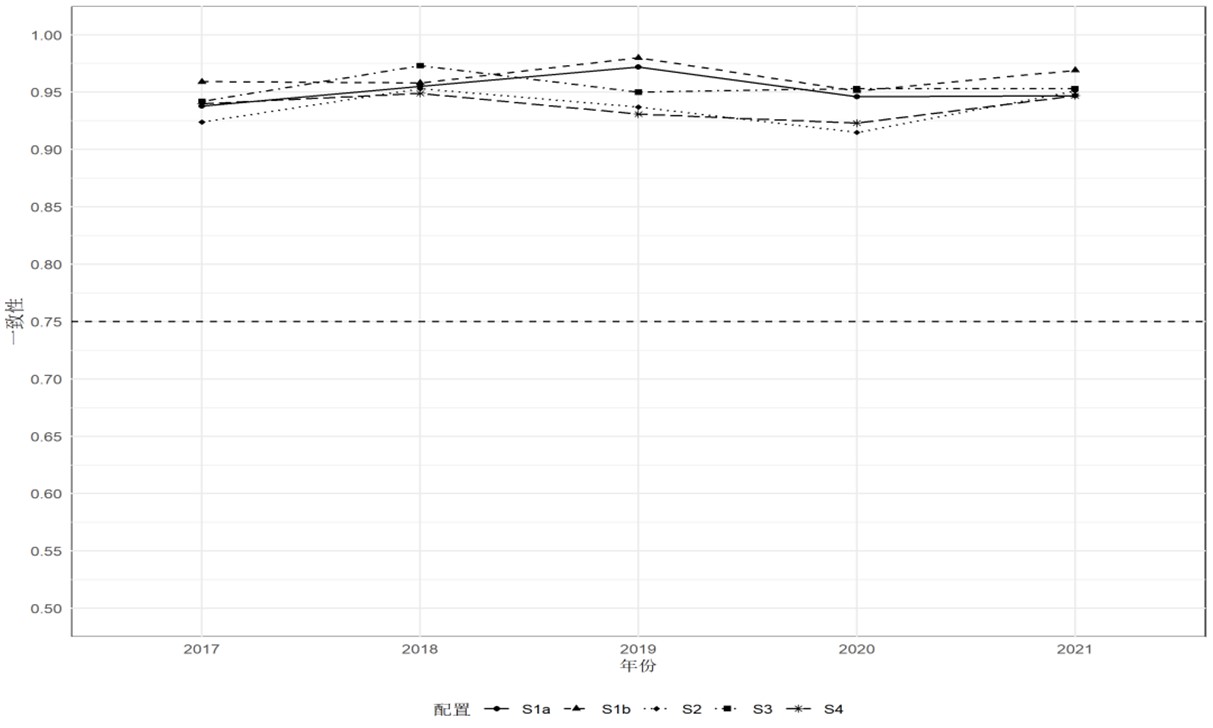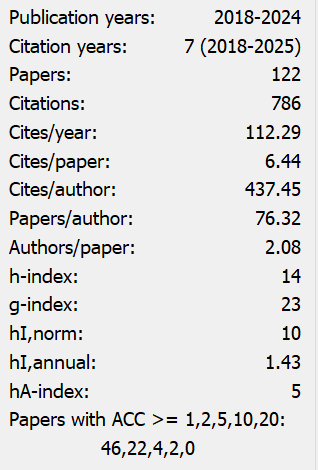Research on Multiple Development Paths of Urban Productivity—Based on Dynamic Qualitative Comparative Analysis (QCA)
Abstract
As the spatial carrier of human economic, social, and cultural development, cities should adapt to the times and situations to usher in a new era of urban development. To achieve this, it is necessary to deeply stimulate the multidimensional driving forces of urban development to guide and propel it forward. Based on China's urban panel data spanning from 2017 to 2021, this paper employs dynamic qualitative comparative analysis methods, grounded in institutional and evolutionary theories, to examine strategies for fostering diverse pathways for urban productivity growth. The key findings are as follows: (1) The concerted effort of multiple factors is crucial for achieving high urban productivity, which can be categorized into three primary models: government-led, credit order-driven, and dual-driven. (2) An analysis of temporal stability reveals that the consistency of these three models experiences a turning point in 2019. (3) Property rights protection and judicial services emerge as relatively stable factors. The study concludes that to break through bottlenecks in urban productivity development, the construction of China's urban business environment must not only be tailored to local conditions but also adapt to changing times.
References
[2] Yan, P., & Wang, B. (2004). Technological Efficiency, Technological Progress, and Productivity Growth: An Empirical Analysis Based on DEA. Economic Research Journal, (12), 55–65.
[3] Luo, D., Li, Y., & Shi, J. (2012). Factor market distortions, resource misalignment, and productivity. Economic Research Journal, 47(3), 4–14, 39.
[4] Gai, Q., Zhu, X., & Cheng, M. (2015). Factor market distortions, monopoly power, and total factor productivity. Economic Research Journal, 50(5), 61–75.
[5] Wei, J. (2000). Veblen Methodological Analysis. Economic Sciences, (2), 110–115.
[6] Qi, T. (2002). Comparison of Ideas on Evolutionary Economics: Veblen, Schumpeter, Hayek. Economic Sciences, (4), 122–128.
[7] Reinert, E. S. (2010). How Rich Countries Got Rich and Why Poor Countries Stay Poor. Chinese University Press.
[8] Yang, K., & Gu, Y. (2022). The changing trend of the economic development gap between the north and the south in the new era of China. Southern Economy, (6), 25–39.
[9] Aldrich, H. E., & Ruef, M. (2006). Organizations Evolving. Sage. https://doi.org/10.4135/9781446212509
[10] Lim, D. S. K., Morse, E. A., Mitchell, R. K., & Seawright, K. K. (2010). Institutional Environment and Entrepreneurial Cognitions: A Comparative Business Systems Perspective. Entrepreneurship Theory and Practice, 34, 491–516. https://doi.org/10.1111/j.1540-6520.2010.00384.x
[11] Whitley, R. (1999). Divergent Capitalisms: The Social Structuring and Change of Business. Oxford University Press. https://doi.org/10.1093/oso/9780198293965.001.0001
[12] Du, Y. Z., Liu, Q. C., & Chen, K. W. (2022). Business Environment Ecology, Total Factor Productivity, and Multiple Modes of Urban High-Quality Development: A Configurational Analysis Based on Complex Systems Theory. Management World, 38(9), 127–145.
[13] Harrison, L. E. (1985). Underdevelopment Is a State of Mind: The Latin American Case. Center for International Affairs, Harvard University, and Madison Books.
[14] Jiang, Y. (2019). The Heteronomy-Based Construction of the Social Credit System. Guangdong Social Sciences, (2), 71–77.
[15] North, D. C., & Thomas, R. (1971). The Rise and Fall of the Manorial System: A Theoretical Model. Journal of Economic History, 31(4), 777–803. https://doi.org/10.1017/S0022050700074623
[16] Aoki, M. (2001). Comparative Institutional Analysis. Far East Press. https://doi.org/10.7551/mitpress/6867.001.0001
[17] Hong, Y. X. (2007). Market Order and Norms. Shanghai Joint Publishing Company and Shanghai People's Publishing House.
[18] North, D. C. (2008). Institutions, Institutional Change, and Economic Performance (H. Xing, Trans.). Shanghai People's Publishing House and Greater China Publishing House.
[19] Xu, H., & Zhou, X. H. (2020). A Study on the Impact of Institutional Environment and Industry-Finance Integration on Enterprise Innovation Performance. Studies in Science of Science, 38(1), 158–168.
[20] Du, Y. Z., Liu, Q. C., & Cheng, J. Q. (2020). What kind of business environment ecology generates high urban entrepreneurial activity? An analysis based on institutional configurations. Management World, 36(9), 141–155.
[21] North, D. C. (1991). Structure and Change in Economic History. Shanghai Joint Publishing Company and Shanghai People's Publishing House.
[22] Zhu, Q. C. (2011). Informal Institutions and Stable Economic Growth. Inner Mongolia Social Sciences (Chinese Edition), 32(4), 88–93.
[23] Jiang, G. Q. (2012). Institutional Barriers to the Transformation of China's Economic Development Mode and Their Overcoming Strategies. Social Scientist, (5), 43–45, 58.
[24] Ye, Z. Y., & Zhuang, Z. W. (2022). Leading Enterprises in Industrial Chains and the Growth of Local Manufacturing Firms: A Driving Force or a Hindrance? China Industrial Economics, (7), 141–158.
[25] Wu, H. H., & Zhang, C. S. (2021). Business Environment and Industrial Ecology: Key Focuses for Stimulating the Vitality of Market Entities. Studies and Exploration, (3), 86–94, 180.
[26] Aoki, M., Kim, H. K., & Okuno-Fujiwara, M. (Eds.). (1998). The Role of Government in East Asian Economic Development: A Comparative Institutional Analysis. China Economic Publishing House. https://doi.org/10.1093/acprof:oso/9780198294917.001.0001
[27] Lu, D. M. (1999). Analysis of the Driving Forces of China's Economic Development. Shanxi Economic Press.
[28] Liu, Z. B., & Wang, B. (2024). Business Environment, Industrial Relocation, and Regional Coordinated Development. Hebei Academic Journal, 44(2), 1–13.
[29] Wan, J. R. (2012). On Integrity: One of the Research Topics in Social Ethics Construction During Social Transformation. Journal of Suzhou University (Philosophy & Social Science Edition), 33(2), 26–30, 191.
[30] Wang, R. L. (2019). Credit, Rule of Law, and the Institutional Foundation of Modern Economic Growth. China Legal Science, (2), 73–89.
[31] Yu, Y. Z., Guo, M. H., & Guo, X. (2019). Review and Prospect of Research on the Economic Effects of Social Credit. Journal of Macro-Quality Research, 7(4), 80–95.
[32] Xu, S. F. (2005). Trust, Social Capital, and Economic Performance. Studies and Exploration, (5), 222–225.
[33] Jing, L. L., & Huang, H. L. (2024). Research on the Stimulation and Impact of Digital Innovation Ecosystems on Regional Innovation Capability from a Dual Dimension of Time and Space: Based on Dynamic QCA Analysis of Provincial Panel Data. Science & Technology Progress and Policy, 1–11.
[34] Du, Y. Z., Li, J. X., Liu, Q. C., & Cheng, J. Q. (2021). Configurational Theory and QCA Method from a Complex Dynamic Perspective: Research Progress and Future Directions. Management World, 37(3), 180–197, 12–13.
[35] Fang, F., Zhang, L. J., & Zhao, J. (2024). Exploring Multiple Paths to Enhance Agricultural Green Total Factor Productivity from an Institutional Configuration Perspective: Based on Panel Data Analysis with Dynamic QCA. Chinese Rural Economy, (2), 44–66.
[36] Beynon, M. J., Jones, P., & Pickernell, D. (2020). Country-Level Entrepreneurial Attitudes and Activity Through the Years: A Panel Data Analysis Using fsQCA. Journal of Business Research, 115, 443–455. https://doi.org/10.1016/j.jbusres.2019.11.021
[37] Zhang, F. (2023). Factors Influencing the Disclosure of Local Government Information: A Dynamic QCA Analysis Based on Provincial Panel Data. Journal of Intelligence, 42(1).
[38] Schneider, C. Q., & Wagemann, C. (2012). Set-theoretic methods for the social sciences: A guide to qualitative comparative analysis. Cambridge University Press. https://doi.org/10.1017/CBO9781139004244
[39] Yu, M., & Pan, H. (2010). Financial development, trade credit, and product market competition. Management World, (8), 117–129.
[40] Xiao, J. (2003). An economic analysis of honesty and trustworthiness. Research on Financial and Economic Issues, (4), 16–19.


This work is licensed under a Creative Commons Attribution 4.0 International License.
Copyright for this article is retained by the author(s), with first publication rights granted to the journal.
This is an open-access article distributed under the terms and conditions of the Creative Commons Attribution license (http://creativecommons.org/licenses/by/4.0/).


























